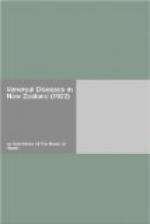These clinics are attached to the public hospitals in each centre, and all evidence goes to show that this is most desirable. If the clinics were apart, the object of the patients’ visits would be obvious, whereas the actual purpose for which they go to a hospital is not so. It is to be strongly emphasized that the less publicity given to the attendance of these patients, the greater the number of patients who will be likely to take advantage of the treatment offered. This applies especially to the attendance of women.
The clinics are now open only at certain hours. The Committee suggest that they might with advantage remain open continuously (except at certain fixed hours on Sunday). In the absence of the Medical Officer a sister could take charge of the women’s clinic, and a trained orderly of the men’s clinic. It would be necessary in this case to have separate clinics for male and female patients—the same rooms would not be available for both sexes.
The majority of witnesses asked were of opinion that if a lady doctor were made available for the treatment of women the number of women attending would increase.
It is suggested that in certain cases of gonorrhoea, where it is an advantage that the treatment should be carried out twice or more often daily, arrangements might he made for the supply of the necessary apparatus and drugs to patients at cost price, and in indigent cases free of charge. This is particularly important to women who may have to continue treatment for several months.
The clinics should be more widely advertised by notices in public conveniences and other suitable places.
The Committee are impressed with the valuable work done at these clinics, and recommend their extension to other centres as opportunity offers and necessity is shown to exist.
The existing clinics are conducted by medical men who have had special experience and training in the treatment of these diseases. The Dunedin clinic is attended by medical students for purposes of instruction. In view of recent advances in the processes of diagnosis and treatment of these diseases, the Committee consider that opportunity should be given to medical practitioners to attend these clinics in order to familiarize themselves with the most recent advances in this field. It would he an advantage also if nurses in the course of their training attended the female clinics, so that they might he taught to recognize the commoner manifestations of these diseases.
The most disappointing feature in the records of the clinics is the cessation of treatment by so many patients before they have ceased to be infective. The following evidence was given in this connection:—
Percentage of Cases attending till Non-infective. Auckland Clinic: 80 per cent. cases of syphilis, 50 per cent. cases of gonorrhoea. It was stated that no woman suffering from gonorrhoea continued treatment till non-infective.




